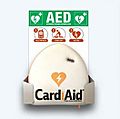Defibrillator facts for kids
A defibrillator is a special machine that can help a person whose heart has stopped beating normally. It's used when the heart's electrical signals get very messy, a problem called ventricular fibrillation. This makes the heart unable to pump blood around the body, which is a serious emergency. A defibrillator is a life-saving device that can help restart the heart's normal rhythm.
When the heart goes into this messy rhythm, it means many tiny parts of the heart are trying to tell it to beat all at once, but not in a coordinated way. Imagine an orchestra where every musician plays their own tune at different times – it would be chaos! This chaos stops the heart from working properly.
A defibrillator sends a strong electrical shock through the heart. This shock briefly stops all the heart's electrical activity. It's like pressing a reset button. After the shock, the heart's natural "pacemaker" (a special part of the heart that usually controls its rhythm) can try to restart a normal, steady beat. However, defibrillation doesn't always work.
Contents
What Kinds of Defibrillators Are There?
There are different types of defibrillators, designed for different situations.
Defibrillators Inside the Body
Some defibrillators are small devices placed inside a person's body. These are called Implantable Cardioverter-Defibrillators, or ICDs. They are for people who are at high risk of their heart stopping. An ICD constantly checks the person's heart rate and rhythm. If it detects a dangerous, messy heart rhythm, it can quickly give a small electrical shock to fix it. This helps to keep the heart beating safely from the inside.
Defibrillators Outside the Body
External defibrillators are used outside the body. You often see them in hospitals and ambulances. More and more, you can also find them in public places. This is because special types of external defibrillators, called AEDs, have become safer and easier for anyone to use.
How Do Modern Defibrillators Work?
Before the 1990s, most external defibrillators used a "monophasic" (one-way) shock. This meant the electricity went in one direction from one pad to the other.
Modern defibrillators use "biphasic" (two-way) shocks. This means the electrical pulse quickly changes direction. This method is better because it needs less energy to work. Less energy means there's less risk of burns or other damage to the skin. It also means the defibrillator can be smaller and cheaper to make, which is great for making them more available.
What Are AEDs?

An automated external defibrillator (AED) is a special type of external defibrillator that is made to be easy to carry and simple for almost anyone to use. They often look like small briefcases with a handle.
An AED has a battery, a control computer, and special sticky pads called electrodes. When you stick the pads onto a person's chest, the computer inside the AED will check their heart rhythm. It then decides if a shock is needed. If it is, the AED will tell you to push a button to deliver the shock. If the person's heart doesn't need a shock, the AED won't let you give one. Many AEDs also have speakers that give clear, step-by-step instructions when you open them.
AEDs are designed for people with little or no medical training, like police officers, security guards, or even regular people who happen to be nearby during an emergency. You can often find AEDs in busy places like airports, sports stadiums, and college campuses, ready to help save a life.
How Do Defibrillators Connect to You?
The part of the defibrillator that delivers the shock to the body is called the electrode.
The oldest and most well-known type of electrode is the metal paddle with a handle. These paddles must be held firmly against the patient's skin. Before using them, a special gel is put on the skin. This gel helps the electricity flow better and reduces the chance of skin damage.
A newer type of electrode is an adhesive pad. These pads are sticky and can be placed directly onto the patient's skin. They stay connected to the defibrillator. If a shock is needed, the machine charges up, and the shock is delivered without needing to apply gel or hold paddles.
There are two kinds of adhesive pads: solid-gel and wet-gel. Solid-gel pads are easier because you don't need to clean the skin afterward. However, wet-gel pads spread the electricity more evenly, which means there's less risk of burns during the shock.
Related pages
Images for kids
See also
 In Spanish: Desfibrilación y cardioversión eléctrica para niños
In Spanish: Desfibrilación y cardioversión eléctrica para niños





